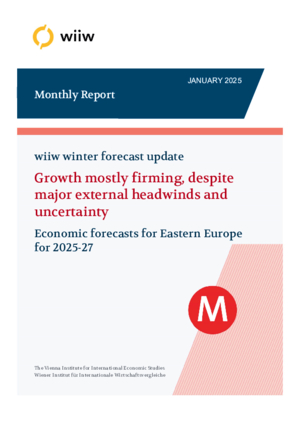Monthly Report No. 1/2025
Vasily Astrov, Alexandra Bykova, Selena Duraković, Meryem Gökten, Richard Grieveson, Maciej J. Grodzicki, Doris Hanzl-Weiss, Gabor Hunya, Branimir Jovanović, Niko Korpar, Dzmitry Kruk, Sebastian Leitner, Isilda Mara, Emilia Penkova-Pearson, Olga Pindyuk, Sandor Richter, Marko Sošić, Bernd Christoph Ströhm and Maryna Tverdostup
wiiw Monthly Report No. 1, January 2025
50 pages including 6 Tables and 13 Figures
OVERVIEW 2023-2024 AND OUTLOOK 2025-2027
Premium Members only
Summary of key recent macroeconomic data for CESEE, and overview of new wiiw forecasts for 2025-2027 (Excel file)
wiiw winter forecast update
Growth mostly firming, despite major external headwinds and uncertainty
Economic forecasts for Eastern Europe for 2025-27
The economic outlook for Central, Eastern, and Southeastern Europe (CESEE) in 2025 is mixed, with overall growth projected to slow to 2.7%. However, this slowdown is primarily due to weaker growth in Russia, with most other countries either maintaining 2024’s growth rate or expanding at a faster pace than last year. Consumption, investment, and EU funds are expected to drive growth, but weak external demand and inflation concerns are significant headwinds that will prevent a faster rate of expansion. The likelihood of new US tariffs, and continued geopolitical tensions, represent downside risks to growth.
Executive summary by Richard Grieveson
Winter 2024/2025 interim forecast update by Statistics Department
1. Global assumptions: Bracing for impact by Richard Grieveson
2. CESEE outlook: Growth mostly firming, despite major external headwinds and uncertainty by Richard Grieveson, Vasily Astrov, Meryem Gökten, Maciej J. Grodzicki, Branimir Jovanović and Olga Pindyuk
3. Country updates:
- Albania: Tourism momentum and economic growth continue by Isilda Mara
- Belarus: Growth slowdown ahead by Dzmitry Kruk
- Bosnia and Herzegovina: Historic increase in the minimum wage to boost the economy by Selena Duraković
- Bulgaria: Schengen Area membership expected to boost the economy by Emilia Penkova-Pearson
- Croatia: Among the euro area’s top performers by Bernd Christoph Ströhm
- Czechia: Domestic strength offsetting external weakness by Richard Grieveson
- Estonia: Economic recovery firming by Maryna Tverdostup
- Hungary: Budget consolidation or a new attempt to accelerate growth? by Sándor Richter
- Kazakhstan: Growth acceleration amid anticipated oil sector recovery by Alexandra Bykova
- Kosovo: Resilient and steady growth by Isilda Mara
- Latvia: Slower-than-expected recovery ahead by Sebastian Leitner
- Lithuania: Domestic and foreign demand driving economic recovery by Sebastian Leitner
- Moldova: Upswing held back by energy crisis by Gábor Hunya
- Montenegro: Hints of growth amidst EU accession hopes by Marko Sošić
- North Macedonia: Still searching for direction by Branimir Jovanović
- Poland: Strong growth driven by domestic demand by Maciej J. Grodzicki
- Romania: Modest recovery from near-stagnation by Gábor Hunya
- Russia: Stubborn inflationary pressures pose a policy dilemma by Vasily Astrov
- Serbia: Moment of truth by Branimir Jovanović
- Slovakia: Start of fiscal consolidation by Doris Hanzl-Weiss
- Slovenia: Despite industry worries, a year of solid growth ahead by Niko Korpar
- Turkey: Navigating a soft landing amid global uncertainty by Meryem Gökten
- Ukraine: Weak growth amid huge uncertainty by Richard Grieveson
Reference to wiiw databases: wiiw Annual Database, wiiw Monthly Database
Keywords: CESEE, economic forecast, Central and Eastern Europe, Western Balkans, EU, euro area, CIS, war in Ukraine, energy dependence, EU accession, EU Recovery and Resilience Facility, economic growth, labour markets, inflation, monetary policy, fiscal policy, GDP, consumer prices, unemployment, current account, fiscal balance, policy rate, exchange rate, political risk, FDI, exports, imports
JEL classification: E20, E21, E22, E23, E24, E31, E32, E5, E62, F21, F31, H60, I18, J20, J30, O47, O52, O57, P24, P27, P33, P52
Countries covered: Albania, Austria, Belarus, Bosnia and Herzegovina, Bulgaria, CESEE, China, CIS, Croatia, Czechia, Estonia, EU-CEE, Euro Area, European Union, Global economy, Hungary, Kazakhstan, Kosovo, Latvia, Lithuania, Moldova, Montenegro, New EU Member States, North Macedonia, Poland, Romania, Russia, SEE, Serbia, Slovakia, Slovenia, Turkey, Ukraine, Western Balkans
Research Areas: Macroeconomic Analysis and Policy
